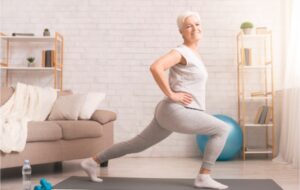We’ve all heard about the importance of staying active as we age, but what happens when we’re ready to head out for a walk, hit the elliptical at the gym, or tango with our favorite partner, only to discover that our joints and muscles don’t want to come to the party?
How can we get our muscles and joints to tag along on our fitness journey, and is it too late to get a little more limber?
At Bellaire at Stone Port, we care about seniors and want to make sure they live their healthiest, happiest lives. We encourage year-round physical activity and believe in the benefits of stretching, and we hope you’ll continue to love and care for your body as you grow older.
Aging & Our Bodies
Our flexibility decreases as we grow older, and a lack of physical activity can significantly exacerbate stiffness in our joints, muscles, and tendons.
Here’s what’s going on: As we age, our muscles lose mass and fibers, tendons and connective tissue become stiffer, and our movement slows. These changes significantly impact our mobility, making lifting, climbing stairs, and bending over more challenging.
Aging is an inevitable and natural process, but you can put off a reduction in your mobility by staying active and ensuring that your joints stay limber. The most crucial piece of the puzzle is movement.
The Perks of a Good Stretch
Seniors with a daily stretching routine may experience these benefits:
- Increased strength and muscle control: Stretching can help improve your stamina with lifting, pulling, and pushing tasks.
- Increased flexibility: Flexibility may seem like an obvious perk to stretching, but a daily routine can make things like bending and turning much easier and less tiring.
- Stress relief: Stretching can help calm the mind when done in conjunction with breathing techniques.
- Improved range of motion: Stretching may help improve the range of motion in your joints.
- Improved posture: Daily stretches can stop your muscles from tightening, helping to maintain proper posture and reduce aches from stiff muscles.
- Reduced muscle tension: Stretching can help reduce muscle tension and soreness in the body.
- Increased blood circulation: Stretching helps increase the muscle tissue’s temperature, inviting more blood circulation into the area.
- Improved coordination and balance: Daily stretching can help increase your range of motion, help prevent loss of mobility, and prevent injuries from falls.
At Bellaire at Stone Port, we recommend seeking advice from a medical professional before starting any fitness routine, including a stretching regimen. They’ll be able to make specific recommendations based on your abilities, physical limitations, and health concerns.
Types of Stretches
The 2 most common types of stretches are dynamic and static.
Dynamic Stretching
Dynamic stretches are active movements repeated in a short period, which allow your muscles to loosen gradually. These stretches help warm up the muscles and prepare them for exercise.
Static Stretching
Static stretches can help lengthen and loosen the body’s muscles. In these stretches, the muscles and joints are held in position for about 15-30 seconds. Static stretching can help relieve muscle tension and improve blood circulation.
How Often Should I Stretch?
The National Institute on Aging recommends mixing stretching and flexibility exercises with endurance, strength, and balance activities to keep your routine fresh and fun.
Other hints for your stretching regime include:
- Perform each stretch 3-5 times.
- Take a deep breath, exhale slowly as you stretch.
- Hold your stretch for about 30 seconds, giving the muscle time to relax.
- Avoid bouncing as you stretch; this can increase your risk of injury.
- Do not stretch to the point of pain; only push to where you feel the tension in your muscle.
- Warm-up for about 5-10 minutes before your stretching regime. You can do this by performing gentle movements or going for a walk.
Stretching Tips & Tricks
Here are a few tips to help you make the most of your new stretching routine.
- Speak to a medical professional before starting any exercise program.
- Be additionally careful if you’ve had any recent surgeries or a hip replacement. Your doctor can recommend the best time to start a new fitness routine, and offer some movements catered to your mobility.
- Remember to warm your body up before you attempt any stretches. Your muscles need to be prepared for motion.
- Stretching should not include pain, and remember only to press until you feel the tension in your muscle. If stretching hurts, stop immediately.
- Aim for slow, gentle, and controlled movements. Sharp moves, bouncing, or jerking can lead to muscle tears and injuries.
- Do not lock your knees or elbows when performing your stretches. You want to keep your joints and limbs a little loose.
- Remember to breathe. Take a deep breath and exhale slowly as you press into your stretch.
Start a New Routine
If you’re looking for a new year-round activity for your health that’s simple and effective, you may want to consider a daily stretching routine. You can personalize your regime in conjunction with a medical professional to maximize the health benefits of stretching.
The team at Bellaire at Stone Port is available if you are a senior with questions about active living and stretching regimes. Contact us today, and let us help you stay healthy and happy!




